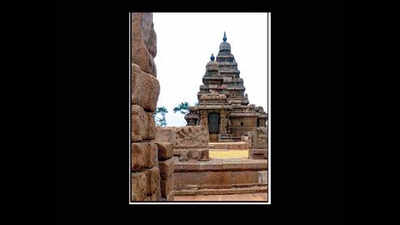- News
- City News
- chennai News
- Artistic skill of Pallavas a gift from Satavahanas, says expert
Trending
This story is from November 18, 2018
Artistic skill of Pallavas a gift from Satavahanas, says expert

CHENNAI: The monuments in Mamallapuram stand testimony to the vibrant artistic tradition of the Pallavas, but from whom did they learn the art? According to S Swaminathan, an expert on Mamallapuram, it’s from the Satavahanas, the dynasty that ruled the region before the Pallavas.
“The Satavahanas were an ancient dynasty that ruled the Deccan region up to the Andhra in the south between 300BC and 300AD.Their artistic achievement was noteworthy. They excavated the early caves in Ajanta, constructed the gateway of Sanchi and crafted the famous Amaravati sculptures. The Satavahanas might have influenced the Pallavas in art,” said Swaminathan, while speaking on “Mahabalipuram: A museum of Pallava architecture and sculpture” at Amethyst cafe in the city recently.
What is now called Mallai (Mamallapuram) was known as a port called Nirpeyarru during the Sangam period and the site has close connections with the Alvars (5th-10th century), said Swaminathan. The Alvars were Tamil saint-poets who regarded lord Vishnu as the supreme being. “Boothattalwar, one of the prominent among the Alvars, was born in Mallai, which was a centre of pilgrimage. In his pasuram (hymns), he upbraids Vishnu for lying on the bare floor. Maybe he was referring to the idol we see in the middle shrine at the shore temple complex,” he said, adding, “from the description that waves lapped the Vishnu image, it can be deduced that it was in the open by the very margin of the sea, perhaps with a mandapa-type temple.”
Despite being a museum of Pallava architecture, Mamallapuram got erased from public memory and it was the Europeans who brought back focus on the site. “The credit for resurrecting the memory of Mamallapuram goes to the Europeans. The first detailed treatment is by William Chambers in 1788,’” said Swaminathan, author of ‘Mahabalipuram: Unfinished poetry in stone’.
The collection of Colin MacKenzie (1754-1821), the first surveyor general of India, also gives a partial view of that period.
“A number of artists have contributed to recording contemporary scenes in Mamallapuram. The most important among them are Thomas Daniell and his nephew William Daniell. The duo travelled throughout India from 1786 to 1794 drawing and painting the landscape views and monuments they witnessed along the way,” he added.
“The Satavahanas were an ancient dynasty that ruled the Deccan region up to the Andhra in the south between 300BC and 300AD.Their artistic achievement was noteworthy. They excavated the early caves in Ajanta, constructed the gateway of Sanchi and crafted the famous Amaravati sculptures. The Satavahanas might have influenced the Pallavas in art,” said Swaminathan, while speaking on “Mahabalipuram: A museum of Pallava architecture and sculpture” at Amethyst cafe in the city recently.
What is now called Mallai (Mamallapuram) was known as a port called Nirpeyarru during the Sangam period and the site has close connections with the Alvars (5th-10th century), said Swaminathan. The Alvars were Tamil saint-poets who regarded lord Vishnu as the supreme being. “Boothattalwar, one of the prominent among the Alvars, was born in Mallai, which was a centre of pilgrimage. In his pasuram (hymns), he upbraids Vishnu for lying on the bare floor. Maybe he was referring to the idol we see in the middle shrine at the shore temple complex,” he said, adding, “from the description that waves lapped the Vishnu image, it can be deduced that it was in the open by the very margin of the sea, perhaps with a mandapa-type temple.”
Despite being a museum of Pallava architecture, Mamallapuram got erased from public memory and it was the Europeans who brought back focus on the site. “The credit for resurrecting the memory of Mamallapuram goes to the Europeans. The first detailed treatment is by William Chambers in 1788,’” said Swaminathan, author of ‘Mahabalipuram: Unfinished poetry in stone’.
“But it was in 1813 that British writer Maria Graham recorded life at the site. She also campaigned against quarrying in the neighbourhood,” he said. Other accounts of European interest in the site include, records of Werner Hoffmeister accompanying a German prince and sailing to Mamallapuram in 1844 and Eliza Ruhamah Scidmore enjoying a leisurely ride along the Buckingham Canal in 1903. “These people had narrated the artistic glory of Mamallapuram in their accounts,” he added.
The collection of Colin MacKenzie (1754-1821), the first surveyor general of India, also gives a partial view of that period.
“A number of artists have contributed to recording contemporary scenes in Mamallapuram. The most important among them are Thomas Daniell and his nephew William Daniell. The duo travelled throughout India from 1786 to 1794 drawing and painting the landscape views and monuments they witnessed along the way,” he added.
End of Article
FOLLOW US ON SOCIAL MEDIA










